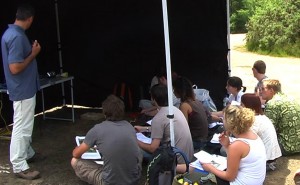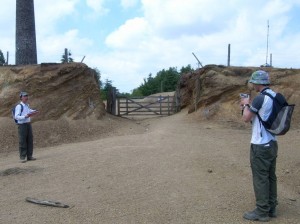At the end of June, we conducted some experiments to evaluate the performance of ERA-assisted fieldwork compared to the same fieldwork task being performed by students visiting the site directly. Four groups of students volunteers visited Devon Great Consols to perform an Environmental Impact Assessment (EIA) task related to a fictional plan to exploit metals available in the waste heaps on the site, left over from its time as an arsenic extraction plant in the late 19th and early 20th centuries.
Two of our four student groups walked around the site whilst Plymouth University’s John Maskall and Paul Lunt explained the history, physical features and processes occurring there, detailing the fictitious plans for development. The other two student groups were set the same EIA task, and heard similar presentations from John Maskall, but viewed the site on a video monitor from the parking area at the top of the site, never directly seeing the detail of the site itself. John delivered his site walk-over survey while Matt Sharples, also of Plymouth University operated a video camera, concentrating on features pointed out in John’s survey whilst trying to provide an overall view of the site. The two remote-viewing student groups were assisted by Paul Lunt (Plymouth University), who was in constant voice-contact with John Maskall during the walk-over and relayed questions and comments from the remote students. All four student groups completed pre and post fieldwork questionnaires, and participated in a focus group discussion, devised and facilitated by Plymouth University’s Alison Stokes.
The students’ completed tasks are now being marked, the results of these, the questionnaires and the focus groups should be available soon. Everyone at ERA would like to thank Plymouth University’s GEES group for their belief in our project and for making these trials possible.

